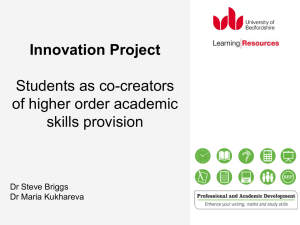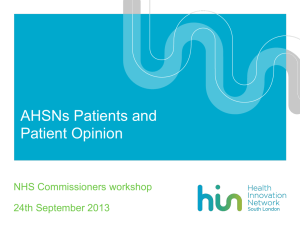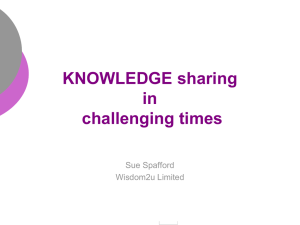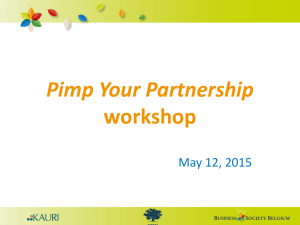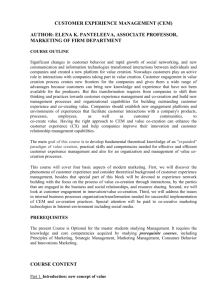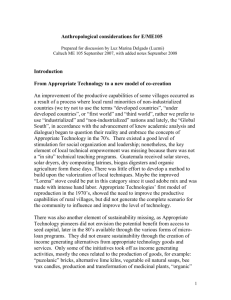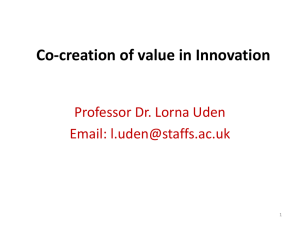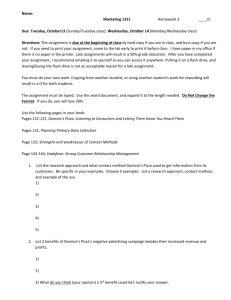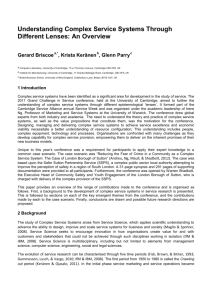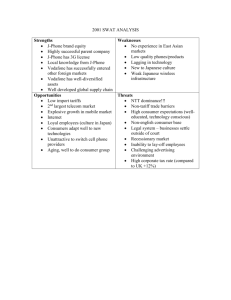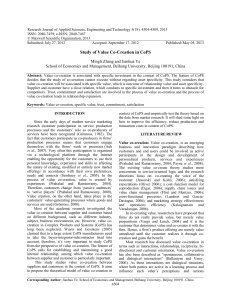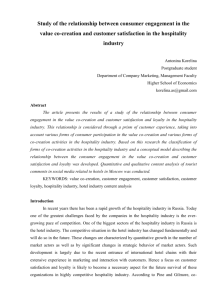view the six-page PDF
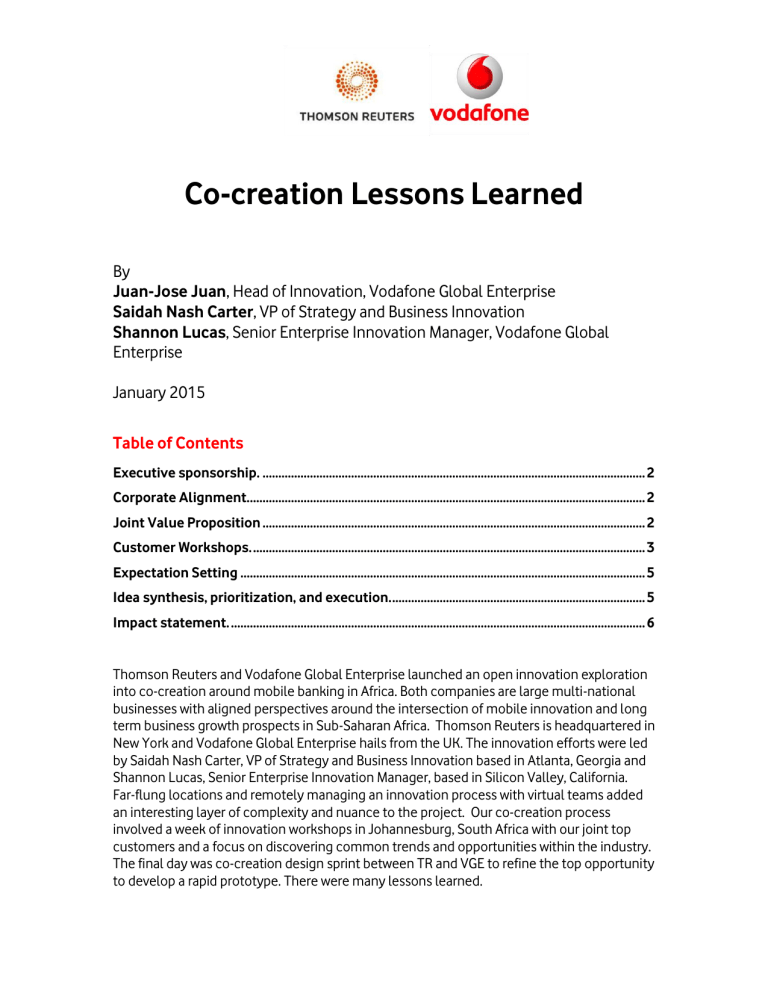
Co-creation Lessons Learned
By
Juan-Jose Juan , Head of Innovation, Vodafone Global Enterprise
Saidah Nash Carter , VP of Strategy and Business Innovation
Shannon Lucas , Senior Enterprise Innovation Manager, Vodafone Global
Enterprise
January 2015
Table of Contents
Executive sponsorship. ......................................................................................................................... 2
Corporate Alignment. ............................................................................................................................. 2
Joint Value Proposition ......................................................................................................................... 2
Customer Workshops. ............................................................................................................................ 3
Expectation Setting ................................................................................................................................ 5
Idea synthesis, prioritization, and execution. ................................................................................ 5
Impact statement. ................................................................................................................................... 6
Thomson Reuters and Vodafone Global Enterprise launched an open innovation exploration into co-creation around mobile banking in Africa. Both companies are large multi-national businesses with aligned perspectives around the intersection of mobile innovation and long term business growth prospects in Sub-Saharan Africa. Thomson Reuters is headquartered in
New York and Vodafone Global Enterprise hails from the UK. The innovation efforts were led by Saidah Nash Carter, VP of Strategy and Business Innovation based in Atlanta, Georgia and
Shannon Lucas, Senior Enterprise Innovation Manager, based in Silicon Valley, California.
Far-flung locations and remotely managing an innovation process with virtual teams added an interesting layer of complexity and nuance to the project. Our co-creation process involved a week of innovation workshops in Johannesburg, South Africa with our joint top customers and a focus on discovering common trends and opportunities within the industry.
The final day was co-creation design sprint between TR and VGE to refine the top opportunity to develop a rapid prototype. There were many lessons learned.
Executive sponsorship.
The most important key to success is strong executive commitment and alignment at all levels and at every step of the way; global leadership teams and local executives (in the region where innovation efforts are focused) should be engaged and onboard from the very beginning. A kickoff meeting including the key executives and innovation teams should identify the capabilities and resources that each company brings to the table for potential areas of joint development. It may be at this point that the core competencies of both companies are either too close or two dissimilar for continued co-creation exploration. In addition, having an open conversation between partners from the beginning ensures that we can avoid any “gotchas” later on. Knowing when to exit or pivot the co-creation process is key to the overall success of each company’s long-term innovation program.
Corporate Alignment.
Once it has been determined that there is enough synergy between the two companies, the leaders commit to a joint development legal agreement dedicating (limited) financial and
(project management) personnel resources to develop an initial rapid prototype within a two to three month timeframe. Local project management resource is particularly important when working in a fast paced growth market where priorities shift quickly and frequently, sustaining a level of focus on the innovation program can be even for a challenge for teams that are often understaffed and constantly fire-fighting. Account managers should help to drive this engagement and tie it back to the day-to-day business activities occurring between the two companies. Account manager engagement ensures that the account team is fully connected to the development of a more robust and strategic relationship that will support the growth of the account over the long term. A dedicated co-creation team should be identified and assembled to manage the process on a daily basis. A global or local innovation team member may lead this, but it should include members from across disciplines to ensure the innovation outcomes receive the execution support needed when the time comes. An executive steering committee should also be assembled to provide regular guidance and gut checks throughout the process. Once the two executive teams have been aligned internally and the co-creation agreement is signed, the co-creation team should engage local teams including local account teams, innovation champions, marketing, PR.
Etc. Stakeholder management is perhaps the most critical success factor when bringing two large companies together.
Joint Value Proposition.
When kicking of a co-creation program it is important to establish a joint purpose and value proposition. These value statements not only provide a mission to rally stakeholders around,
but also offer an articulation of the co-creation effort’s unique value. The joint value proposition is useful both internally, when explaining the partnership to key leadership and externally, when discussing the initiative with joint-customers. In our mobile banking innovation example, Thomson Reuters’ content and financial services domain expertise paired perfectly with Vodafone’s mobile platform and technology expertise to deliver a great innovation discussion to our customers. The value proposition was clear and compelling for all stakeholders.
Customer Workshops.
Both Thomson Reuters and Vodafone Global Enterprise believe that engaging customers early in the innovation and new product development process provides valuable insight into what potential innovations would be most impactful. Innovation Workshops, based on design-thinking principles, are at the heart of our innovation programs. This was our model for exploring co-creation opportunities, jointly sponsoring workshops with our top mutual customers. Organizing these events requires at least a six-month lead-time, to manage the stakeholders and participants from all three companies. To engage the appropriate senior level executives from the customers, it’s important to leverage the executive relationships from both sides. Having a strong local marketing and event lead is also essential to help organize the customer events.
At Vodafone we have conducted over 200 customer Innovation Workshops and we have learned some key determinants to success. Thomson Reuters is newer to the Innovation
Workshop process but both organizations agree on the key tenets. Here are some tactical tips:
Innovation Advocate
. Identifying an Innovation Advocate on the customer side
is the key for successful workshop recruiting. This advocate is someone who is comfortable with the innovative process and working in grey space. Importantly, they are senior enough within the organization and have enough social and political capital with the senior level decision makers to convince them to attend.
They must also have a wide enough network in the organization to bring the change agents and domain experts. The Innovation Advocate understands the power of open innovation and knows that their company’s success will also depend on strong partnerships.
The right people.
The most important determinant to success is having the right stakeholders in the workshop – you need the right mix of change agents, senior execs, and domain experts. We cannot emphasize enough the importance of this step. A conversation is only as good as the participants. In order to ensure the best conversation, we moved the workshop dates from June to October to allow for additional recruitment time. Leveraging your executive’s relationships, where they exist, is a great way to ensure the appropriate customer attendance. But in our experience, finding an Innovation Advocate is most successful way to engage the appropriate customer executives. Finding potential advocates and attendees is often a matter of leveraging social networks – through executive engagement,
personal connections, and online research. The key is to start conversations with the Advocates as soon as possible in the process to a) ensure you have found the appropriate person and b) give them time to engage their executives.
Dinner.
Establishing trust amongst participants is critical. Creating an environment which encourages curiosity; allows for creative thought and copious questioning is of massive value. Dinner the night before the innovation workshop can serve as the best ice-breaker. It helps to develop the relationships of trust that foster openness and the ability to challenge and engage critical thinking the next day. Our co-creation conversation was originally kicked-off over dinner the night before an Innovation Workshop.
Creative Space
. As hinted above, creating a safe space is another big influencer on the innovation process. The d.school at Stanford and leading design-thinking companies like IDEO have written extensively about the many considerations for creating a space that fosters collaboration and creativity. Our innovation workshops are intended to go through the first three steps of the design thinking process (empathize, define, ideate); the prototyping and testing phases come later.
It’s important to get people out of their normal environment into a space that is unique, creative, open and informal. People should feel comfortable and safe. In order to encourage people to tap into their creativity, they should be relaxed.
Whiteboards, chalkboard and post-its are key tools for sharing ideas and building upon them, voting, consolidating, and ideating. The more creative the space the better. A graphic artist can be a great tool to help to capture the major points during the session and provide a canvas that the participants can respond to and interact with. The pictures can also help as artifacts that can galvanize stakeholders beyond the session.
Marketing Support.
The devil is in the detail and a top-notch marketing an events team must be dedicated and fully on board to pull it off.
A event handler
. In addition to the workshop facilitator(s), there needs to be someone in the room responsible for the details throughout the day (photos, white board pen replacement, Wi-Fi access, catering management), etc.
Information Captains
. (Sophisticated notetakers) These critical attendees must have enough local business knowledge to sensibly capture the opportunities and to connect the challenges to the opportunities. We recommend having one from each hosting company if possible.
Overdocument
. Photos. Photos. Photos. In today’s age of the instant digital photo that can be shared many times in a matter of seconds, capturing the participants and the event as it unfolds is an important bonus. It not only helps to capture the energy of the day, but serves as a poignant reminder of the work and the participants’ contributions.
Customer preparation
.
Of course, a nice dinner and a cool space aren’t the only things that make a workshop successful. Setting expectations with all the attendees from the very beginning ensures the right level of commitment and participation. The most strategic customer attendee should be able to share the
three-year corporate strategy and each individual should also be asked to come ready to share the top three challenges and opportunities facing them in their lines of business. This helps to get the conversation going about the art of the possible.
At the end of the session, a list of opportunities should be identified and prioritized by all the attendees. Then the real work of pursing the opportunities begins.
Expectation Setting
For an event of the size and scope of the Innovation Week in Johannesburg, we agreed that pre-work would be important factor in our success. We wanted to ensure that the participants had a basic understanding of the breadth of our two companies and why we decided to partner together on a mobile banking initiative in Africa. We sent each confirmed attendee an application which included a handful of carefully selected documents. Each document communicated something rich and relevant to the audience and the workshop goals. We also notified participants that they had “homework” to prepare for the session.
This gave each person time to consider their personal vision of the challenges and opportunities facing the business in the next three years.
Delivery about this approach, so we won’t expound upon it here, aside from saying that it’s important to do everything you can do to allow people to tap into and believe in their creative capacities.
Idea synthesis, prioritization, and execution.
After the workshop is when the real work begins. If you have facilitated workshops with multiple joint customers, an internal debrief session between the co-creation partners allows for a consolidation and prioritization of the ideas generated. The identified opportunities can be further prioritized based on the capabilities and overall business objectives of the two organizations. Determining which potential prototypes are closest to the core DNA of the two companies will increase the likelihood of success and ensure a focus on a quick win to continue the momentum from the workshop. There will likely be many opportunities to come out of a session of this sort so maintaining the momentum needed to execute against both short term and long term opportunities is key. Get a quick win and build from there. It is important that the executive steering committee attends this session and contributes to the finalization of the list of projects. This list should be consolidated and mapped to the current capabilities and business objectives of both companies.
Dedicated local Innovation resources are essential to execute on the ground. It is extremely difficult to manage these programs remotely. These team members can help maintain awareness and commitment of local stakeholders, maintain key regional executive relationships and move activities forward in local time zones. Cultural awareness and sensitivity to local corporate culture can preempt possible pitfalls in the process. This local
Innovation team member would be part (formally or informally) of the global innovation team, responsible for local execution.
Follow-up, follow-through and persistence are what will ultimately drive results.
Impact statement.
Would we do it again? Absolutely.
Overall, the process was multi-pronged with many moving parts, but the benefits were many.
In addition to establishing more strategic, innovation focused relationships with our joint customers we also solidified a foundation of co-creation and partnership between Thomson
Reuters and Vodafone that will pay value dividends in the African economy for a while to come.
We now have much stronger executive alignment at all levels across both organizations that will support the development of prototypes, the launch of new products and future innovation and collaboration in Sub-Saharan Africa as well.
Perhaps most importantly, we have much more visibility into the opportunities and challenges our customers face so that we can either adjust existing offerings or create new ones. We identified real opportunities to pursue over the short, mid and long term with each bank and with each other.
It is equally important to measure the success of the workshop through the eyes of the workshop attendees. Sending a survey within a week of the workshop is critical so that the feedback is fresh and actionable.
Also, pioneering innovation practices in new markets establishes our companies as thought leaders. Customers highlighted the sharing of our innovation practices as a key value derived from the workshop.
